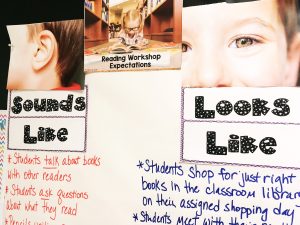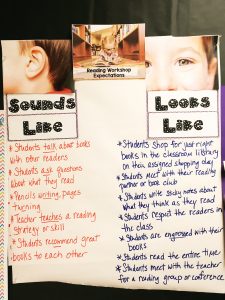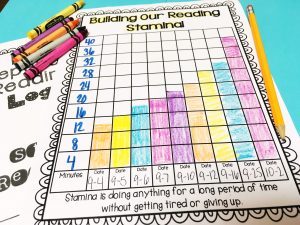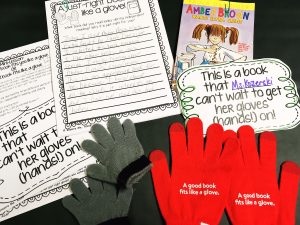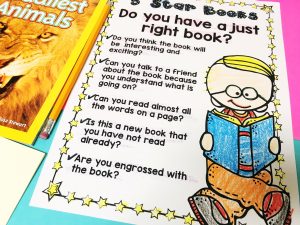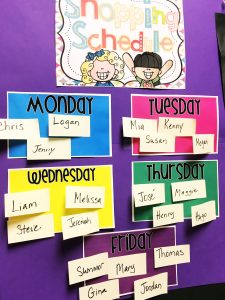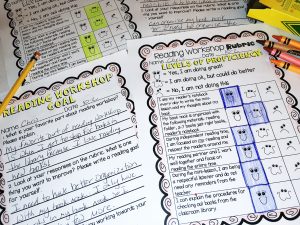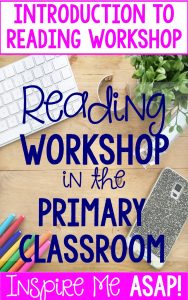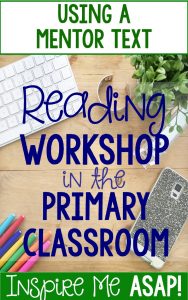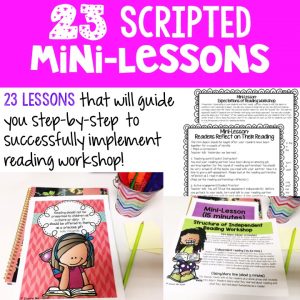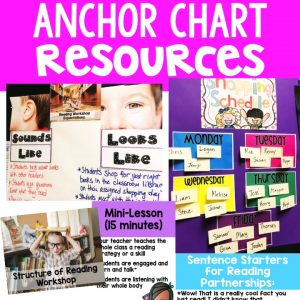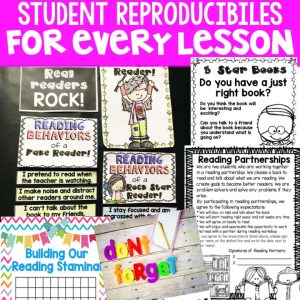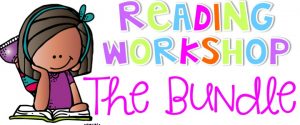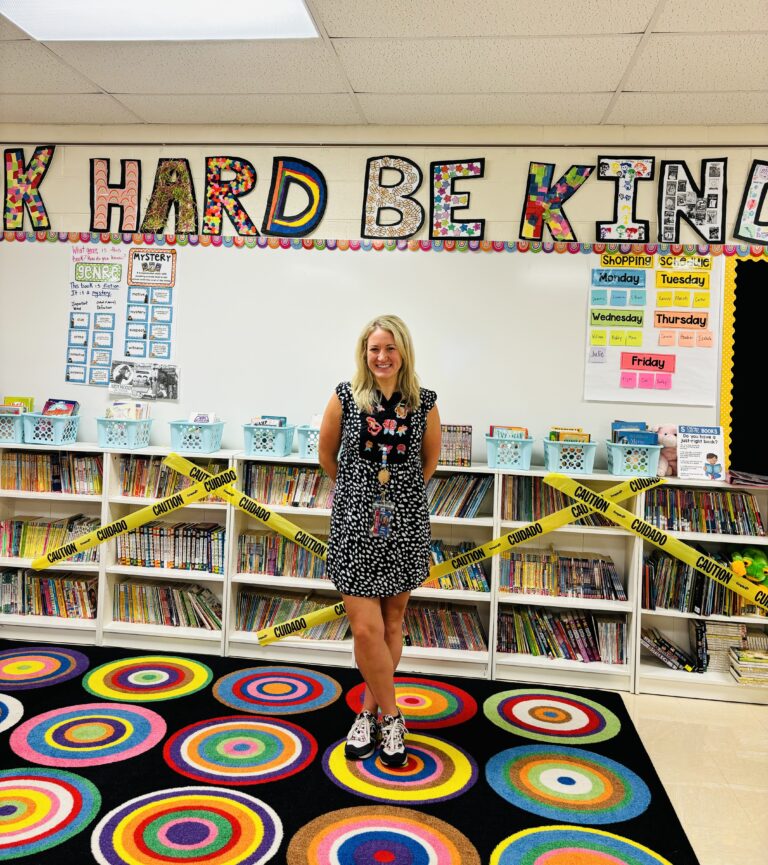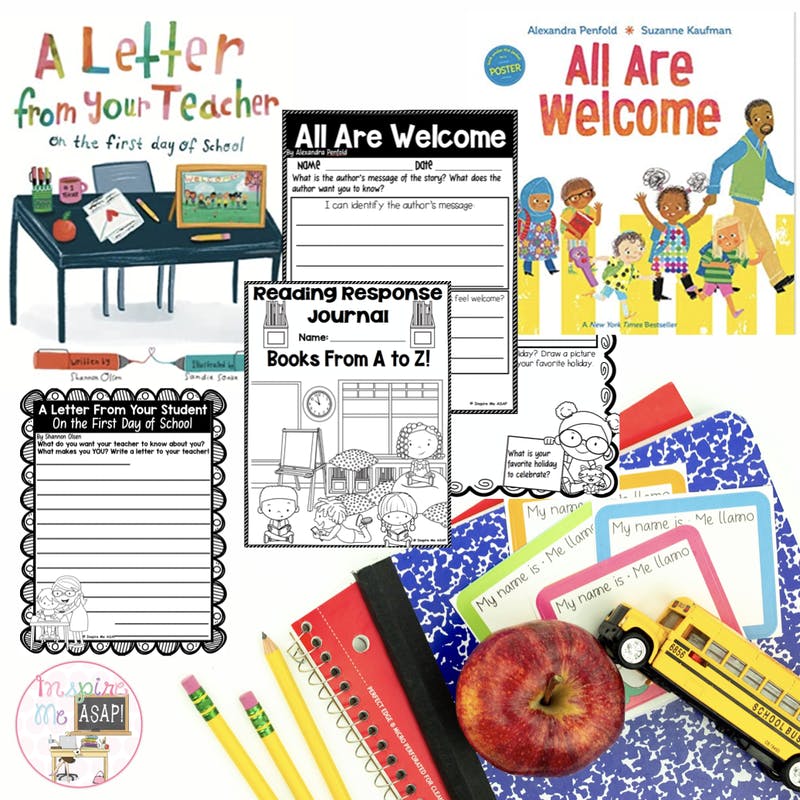
This is my second post about implementing reading workshop in the primary classroom. In my first post, click HERE to read, I introduced what reading workshop is and benefits of using this approach to teach reading in your classroom. Today, I will specifically talk about how to implement reading workshop into your classroom, whether it be at the beginning of a new school year or any time during the school year.
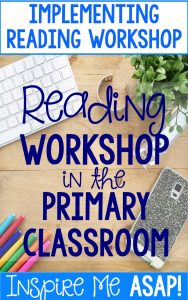
Before you dive right into reading workshop with your students, you will want to take a few weeks to teach different management mini-lessons, which focus on the expectations and structure of reading workshop. These management mini-lessons are a critical part of your overall success with implementing reading workshop, because it establishes the tone for the rest of the school year.
Think about it this way…At the beginning of a new school year, you spend lots of time teaching procedures for using the bathroom, having a fire drill, sharpening pencils, walking in the hallways, turning in homework… Any teacher will tell you that it is imperative to take time at the beginning to set expectations for your classroom. A successful student knows what to for every part of the school day. Implementing workshop is similar in the sense that what you do NOW will establish the tone for the rest of the school year. Successful readers know exactly what do to during reading workshop.
In today’s blog post, I am writing about the procedural mini-lessons that you must teach in order to successfully implement reading workshop in the primary classroom.
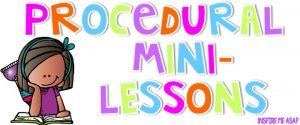
- Readers can identify the structure of reading workshop- mini-lesson, independent reading, sharing/closing.
- Readers identify and follow reading workshop expectations to build reading stamina.
- Readers use book nooks to organize all of their reading workshop materials.
- Readers choose just-right (or appropriate) books from the classroom library on their assigned shopping day.
- Readers reflect on their growth as a reader.
Although I list 5 procedural mini-lessons, keep in mind that depending on the grade level you teach, you may need to break them up into additional lessons. Or, you may have more than one way to teach each mini-lesson, so you may want to extend to the following day. In example of the first mini-lesson about teaching the structure of reading workshop, I actually do a couple of mini-lessons about this topic, over the course of a few days. Again, the reason in doing this is to keep your mini-lessons truly MINI, which means NO more than 15 minutes! ( Read more about that here! ) Ok, with that being said, let’s start with one of the first procedural mini-lessons to teach when implementing reading workshop….
Must-Teach Mini-Lesson #1: Teaching the Structure of Reading Workshop

One of my favorite ways to teach about the structure of reading workshop is with a LOOKS like and SOUNDS like chart. Below is a picture of the anchor chart that I create when I teach a mini-lesson about what reading workshop “looks like”. I love to add real photographs of my students in anchor for my anchor charts! It is so motivating for my students to see me taking their picture and then using it for our anchor chart.
Reading Workshop LOOKS Like:
- Students shopping for just-right (or appropriate) books in the classroom library on their assigned shopping day
- Students meeting with their reading partner or book club
- Students respecting the readers in their class
- Students writing sticky notes about what they think as they read
- Students are engrossed with their books
- Students reading the entire time
- Students meeting with the teacher for a reading group or conference
- Students staying in one spot of the room during independent reading
- Students laughing and smiling at happy parts of their books
- Students engaged with their reading
Reading Workshop SOUNDS Like:
- Students talking with about books with other readers
- Students asking questions about what they read
- Students recommending great books to their friends
- Pencils writing, pages turning
- Teacher teaching a reading strategy or skill
- Students laughing when they get to a funny part in the story
I also have my students sort different reading behaviors according to “real” readers and “fake” behaviors. In past years, I actually had my students dress up as rock stars! Yes, literally, dress up in their best rock n’ roll gear…all in celebration of their rock star reading status!
 As students sort each reading behavior, we talk about the reason why it would be considered a positive or a negative behavior of a reader. Some of the behaviors of “fake” readers are actually a surprise for students. For example, one reading behavior is, “I whiz through the pages.” I had one of my students really believe that this was a good thing because it meant he was reading lots of books. I had to take time to explain and model how S-L-O-W-L-Y reading is actually a good thing because it means that you are thinking about what you are reading!
As students sort each reading behavior, we talk about the reason why it would be considered a positive or a negative behavior of a reader. Some of the behaviors of “fake” readers are actually a surprise for students. For example, one reading behavior is, “I whiz through the pages.” I had one of my students really believe that this was a good thing because it meant he was reading lots of books. I had to take time to explain and model how S-L-O-W-L-Y reading is actually a good thing because it means that you are thinking about what you are reading!
I actually hang these up as a bulletin board at the beginning of the school year. Then, when I take them down, I keep a few of them to hang up by my guided reading table. It serves as a good reminder for expected reading behaviors during independent reading.
Must-Teach Mini-Lesson #2: Readers identify and follow reading workshop expectations to build reading stamina.
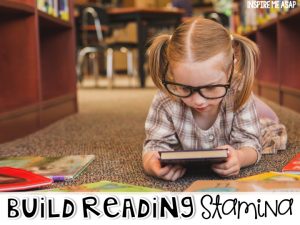
How do you become a better swimmer? You swim. A lot. How do you become a better cook? You cook. A lot. How do you become a better reader and writer? You are reading and writing….a lot! When I introduce reading stamina to my students, I begin by showing them a medal from the Chicago Marathon. I explain that I can’t expect to run 26.2 miles after just two weeks of running. Training for an endurance event takes courage, strength, time, commitment, and support from coach. I have to build up my running stamina and increase my mileage by no more than 10% every week- the cardinal rule of training for a marathon! I use this experience of training for a marathon as an analogy to building reading stamina.
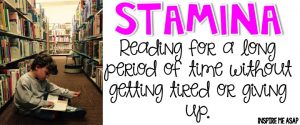
In my third grade classroom, we start our independent reading at 5 minutes. We add a couple of minutes every day and track our growth for the month. At the end of the month, we are up to about 35 minutes of independent reading. This does not happen overnight. A first grade classroom might start at 2 minutes and increase by two minutes every day or every other day, eventually working up to 20 or 25 minutes. Conversely, a fifth grade class might start at 10 minutes. Here is the key- no matter what grade you teach…BELIEVE that your students are capable of this work! You set the stage for teaching your students that reading is to be enjoyed, cherished, and a privilege…..so they have the opportunity to read every day for a set amount of time. It is all about how you present this time to your readers.
My students log the growth of our reading stamina on their own personal chart (which they LOVE to do!) and keep this inside of their book nook. Which leads me to my next must-teach mini-lesson…
Must-Teach Mini-Lesson: Readers use book nooks to organize all of their reading workshop materials.

Book nooks are a place for readers to keep all of their reading workshop materials organized. As soon at reading workshop begins, my students get their book nooks out, place them on their desk, and then come to the carpet for the mini-lesson. This signals the start of reading workshop. My students keep a reading folder in their book nook, which holds their reading log and any other important reading mini-lessons, such as the building stamina growth chart. In addition, my students keep a reader’s notebook to write daily responses to what they are reading. Every day, my students write the date, mini-lesson, and a few sentences about their book they are reading and/or how they are applying the mini-lesson to their independent reading. My students also keep 3-5 books from the classroom library inside of their book nooks.
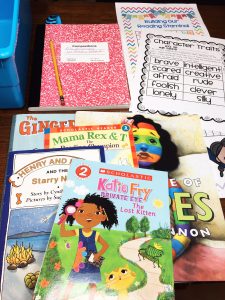
Once I teach about the general materials that stay inside a book nook, I then introduce the reader’s notebook. I show an example of few reader’s notebooks from in the past years, and explain how they are a special spot where readers can write down what they are thinking about what they are reading. Occasionally I will give them a picture to glue down in their notebook, such as below. This serves as a visual reminder for the mini-lesson and the students love to use real photographs from our classroom mini-lessons.
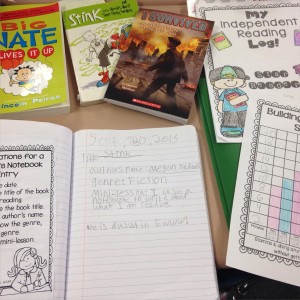
If you are looking to learn more about book nooks, please check out my detailed blog post HERE. If you are looking to learn more about my reader’s notebooks, you can look HERE.
Must-Teach Mini-Lesson #4: Readers choose just-right (or appropriate) books from the classroom library on their assigned shopping day.

BEFORE my classroom library opens, which I *literally!* have a grand opening for….I teach about just-right or appropriate books. My readers are not allowed to go book shopping until they understand this concept. I do NOT have my classroom leveled by Fountas and Pinnell reading levels. ((( I used to, and you can read more about how and why I made this change by clicking HERE. ))) Instead, my library is leveled by genre, author, subject, and series.
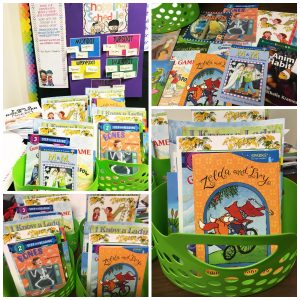
As I mentioned, my classroom library remains closed until the grand opening and all procedural mini-lessons are taught. In the meantime, I give each table (there are a total of 5 tables in my room; 24 students) a basket filled with books of all levels, authors, genres, subjects, and interests. Each table must work together to treat all books with respect. That means that all spines are facing the same way, bigger books are in the back, and readers take and place books gently. Readers must demonstrate that they can use books from the basket respectfully before they get to use the classroom library and receive their very own book nook. (More on book nooks in a bit!)
I teach about appropriate, or just-right fit books, by modeling a pair of too small, too big, and “just-right” winter gloves. There are many different variations to this lesson, I found a way that works best for me!
Whichever method you choose, you will want your students to know what a “just-right” book is for THEM. This is imperative, especially if your classroom library is not leveled by reading levels. Reading workshop is all about empowering your students to self-select their own books from the classroom library!
Once my students demonstrate understanding of appropriate choice of books, THEN I introduce a shopping schedule.
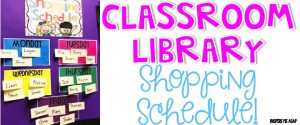
There are a couple of ways that you can do this. You can write each student’s name on a sticky note and then place them on one day of the week.
Or, you can also assign each table to a day of the week. I like to use sticky notes because I can simply change up the schedule if we do not have school a day, if there is an absent student, or if there is a student who might need to go shopping more than one day a week. (For example, if a student is not reading chapter books, they would need to change books more than once a week.)

Once all my students understand just-right books and their shopping schedule, the classroom library is ready for its grand opening. Yep, you read that right. We have a GRAND OPENING….literally…for our classroom library. We invite our principal by writing a letter to him, requesting his presence. our principal shows up at our grand opening (wearing HIS just right fit gloves!) and cuts the caution tape off of the bookshelves.

Now, I very briefly explained different lessons about opening up the classroom library. Please know that this is a BIG deal in my classroom. I make this a BIG deal so students are excited about the opportunity to start shopping and self-selecting books from the classroom library.
Must-Teach Mini-Lesson #5: Readers Reflect on Their Growth as a Reader

How do you know when your students are ready to move away from procedural based lessons? Good question! Obviously, you will be able to observe many of these behaviors. Are the students engaged during their independent reading? Are they shopping for books on their assigned shopping day? One way that I know my work is “done” so to speak, is to have the students reflect on their learning with a reading workshop rubric.
One of my favorite ways to celebrate the growth of my readers (at the beginning of the year) is to invite our principal inside our classroom for the grand opening of our classroom library. Throughout the school year, I celebrate the growth of my readers in many different ways. I am not going to go into depth about that in this blog post, because that will be my last blog post in my 8 post series….stay tuned!
As I mentioned at the beginning of this blog post, although these are listed as 5 mini-lessons, I extend them into several different days worth of mini-lessons, to really make sure that I stay true to the 15 minutes of a mini-lesson. What that begin said, it takes about three weeks to successfully and effectively teach these procedures. A complete list of procedural mini-lessons that I teach are included in my Reading Workshop Unit One Resource. Once these procedures are in place, you are then ready to move onto reading strategy and skill based mini-lessons. I will talk about this during my “using a mentor text” post in my upcoming series.
What to learn more about Reader’s Workshop?
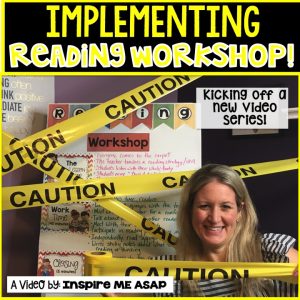
Check out my video series by clicking on the links below!
View my videos on my Teachers Pay Teachers Store: Readers Workshop Video Series
View my videos on my YouTube Store: Reading Workshop Video Series
Reading Workshop in the Primary Classroom Blog Post Series
Take a sneak peak at what is next in this 8 post series!

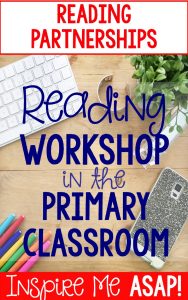
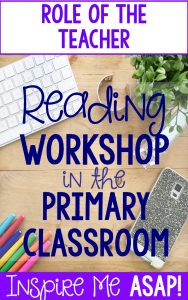


Now, I would LOOVE to hear from you! What are some mini-lessons that you teach to help you implement RW at the beginning of the school year? Do all teachers at your school use a workshop approach? What questions do you have for me?
The ideas on this post are from my Reading Workshop (Unit One) resource. This resource includes 23 scripted mini-lessons to help you get reading works hop implemented in your classroom!
Read more about my reading workshop resources listed below.
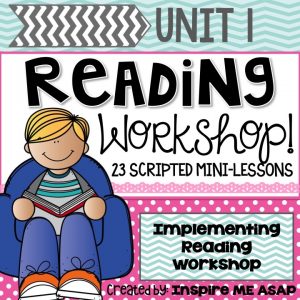
This reading file will help you implement reading workshop in your primary classroom. Looking to implement reading workshop in your primary classroom? This 120 page file has everything you need to know in order to effectively implement a reading workshop approach with your rockin’ readers. More importantly, it will inspire your students to develop a love for reading time.
There are 23 mini-lessons that are included in this file, which focus on establishing routines and setting expectations for implement reading workshop with your students.
During this unit, readers will learn to:
-Follow the structure of reader’s workshop (mini-lesson, independent reading, closing)
-Self-select books that “fit like a glove” from the classroom library
-Take a browse through the classroom library for just-right books
-Take ownership over the classroom library by cleaning book baskets and organizing books
-Use a book check out form to check out books in an organized manner
-Use library stick holders to aid their book shopping
-Use a shopping schedule to check out books on an assigned day
-Use book nooks to keep all their reading materials organized
-Celebrate the grand opening of the classroom library
-Commit to expected reading behavior- RW contract signing party
-Demonstrate specific behaviors of real readers (this includes a fun rockin’ reader art project)
-Build their reading stamina and chart growth
-Use reader notebook’s
-Read with a reading partner during reading partnerships
-Demonstrate expectations for reading partnerships
-Work together to solve problems that arise during reading partnerships
-Read with their partner and discuss the text
-Meet with the teacher for a reading conference
-Reflect on their reading partnerships
Save 10% by purchasing directly from my website.
Or, purchase this resource from my Teachers Pay Teachers store by clicking HERE.
This reading workshop (Unit 1) resource is part of my reading workshop bundle.
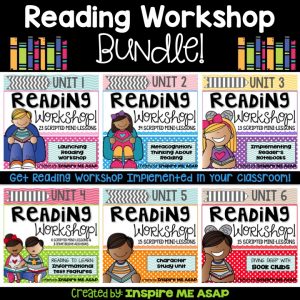
Unit included in this bundle:
Unit 1, Implementing Reading Workshop in your Primary Classroom
Unit 2, Reading Workshop: Reading is Thinking
Unit 3, Implementing Reader’s Notebooks
Unit 4, Informational Text Features
Unit 6, Diving Deep with Book Clubs
Other resources included in this bundle:
Classroom Library Kit
Reading Workshop Book Awards Celebration
You can purchase the BUNDLE on my Teachers Pay Teachers store by clicking HERE.
Save 10% by purchasing this bundle directly from my website.

